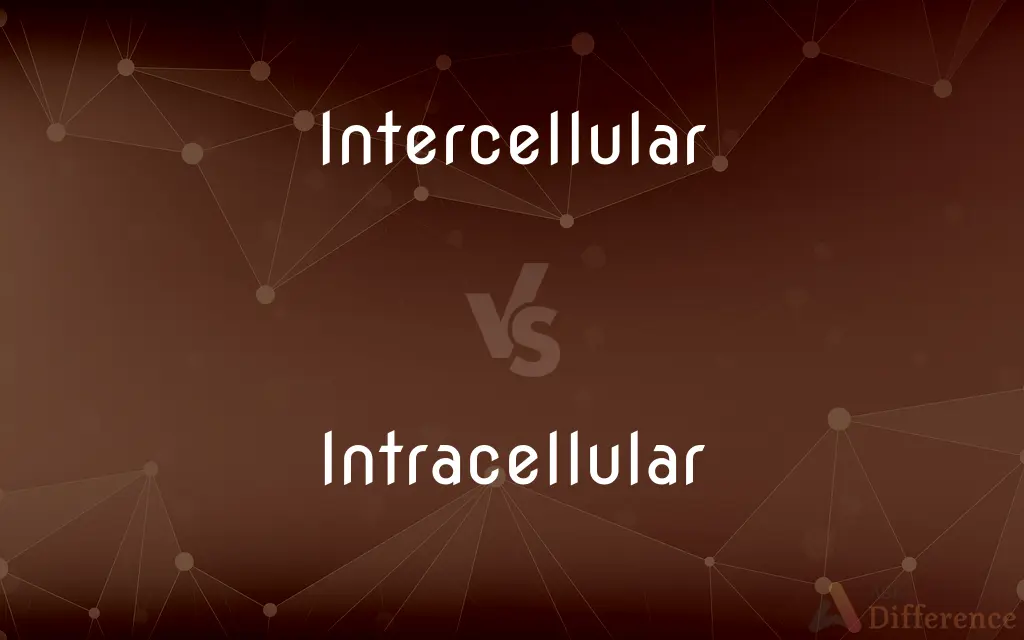Intercellular vs. Intracellular — What's the Difference?
By Maham Liaqat & Urooj Arif — Updated on March 13, 2024
Intercellular refers to spaces or interactions between cells, while intracellular is within a single cell.

Difference Between Intercellular and Intracellular
Table of Contents
ADVERTISEMENT
Key Differences
Intercellular communication involves signals or substances moving between cells, facilitating coordinated responses in multicellular organisms. This is crucial for processes like hormone signaling and immune responses. On the other hand, intracellular processes occur within a cell, encompassing activities such as DNA replication, metabolic reactions, and protein synthesis. These internal mechanisms ensure the cell's survival, replication, and function.
The intercellular space is filled with extracellular matrix (ECM) components, such as collagen and proteoglycans, providing structural support and mediating cell communication. This space plays a vital role in tissue formation, wound healing, and cell adhesion. Conversely, the intracellular environment is composed of various organelles, like the nucleus, mitochondria, and endoplasmic reticulum, each with specific functions contributing to the cell's overall operation.
Intercellular connections, including gap junctions, tight junctions, and desmosomes, facilitate direct communication and material transfer between cells, ensuring tissue integrity and coordinated functions. In contrast, intracellular transport mechanisms, such as vesicular transport and molecular motors, move substances within cells, supporting intracellular trafficking and signaling.
In terms of signaling, intercellular communication relies on signaling molecules, like neurotransmitters and cytokines, which travel between cells to elicit responses. This contrasts with intracellular signaling pathways, such as kinase cascades and second messenger systems, which transmit signals within a cell to regulate its activity.
Intercellular interactions are also key in immune surveillance, where immune cells communicate with and identify potentially harmful cells in the organism. Intracellularly, the cell's innate immune responses, like the interferon response, protect against viral infections and other intracellular pathogens.
ADVERTISEMENT
Comparison Chart
Location
Between cells
Within a single cell
Communication
Through signaling molecules and cell junctions
Via intracellular signaling pathways
Structural Components
Extracellular matrix (ECM)
Organelles like nucleus, mitochondria
Functions
Coordinated responses, tissue integrity
Metabolism, DNA replication, protein synthesis
Examples
Gap junctions, cytokines
Kinase cascades, vesicular transport
Compare with Definitions
Intercellular
Relies on signaling molecules to mediate interactions.
Cytokines are intercellular proteins that modulate the immune response.
Intracellular
Relating to the inside of a cell.
Intracellular enzymes catalyze reactions within the cell.
Intercellular
Involves the extracellular matrix for support and adhesion.
Collagen provides structural integrity to tissues through intercellular spaces.
Intracellular
Includes metabolism and protein synthesis.
The mitochondria are involved in intracellular energy production.
Intercellular
Includes gap junctions for material transfer.
Cardiac cells use gap junctions for electrical signal transfer.
Intracellular
Uses vesicular transport for molecule movement.
Proteins are transported intracellularly from the ER to the Golgi apparatus.
Intercellular
Plays a role in immune surveillance.
Immune cells communicate intercellularly to identify and attack pathogens.
Intracellular
Contains specialized structures like the nucleus.
DNA replication occurs within the intracellular nucleus.
Intercellular
Located among or between cells
Intercellular fluid.
Intracellular
Involves pathways like kinase cascades.
Intracellular signaling pathways regulate cell growth and division.
Intercellular
Located between, or connecting, cells
Intracellular
Occurring or situated within a cell or cells
Intracellular fluid.
Intercellular
Located between cells
Intracellular
Inside or within a cell.
An intracellular process
Intracellular
Within a cell; as, the intracellular movements seen in the pigment cells, the salivary cells, and in the protoplasm of some vegetable cells; intracellular enzymes. Contrasted with extracellular.
Intracellular
Located or occurring within a cell or cells;
Intracellular fluid
Common Curiosities
Can you give an example of intracellular organelles?
Examples include the mitochondria for energy production and the nucleus for DNA storage.
What is intracellular?
Intracellular pertains to events or structures within a single cell.
How do gap junctions function in intercellular communication?
Gap junctions allow direct material transfer between cells, facilitating coordinated responses.
How does intracellular signaling regulate cell activity?
It uses pathways like kinase cascades to transmit signals within a cell, affecting functions like growth.
Can intracellular mechanisms affect intercellular communication?
Yes, intracellular reactions can produce signals affecting other cells, linking intracellular and intercellular processes.
What does intercellular mean?
Intercellular refers to spaces or activities occurring between different cells.
How do intercellular and intracellular communication differ?
Intercellular communication involves signals between cells, while intracellular communication occurs within a cell.
Why is intercellular communication important in the immune system?
It enables immune cells to communicate and coordinate attacks on pathogens.
How do cytokines function in intercellular communication?
Cytokines are signaling molecules that modulate immune responses by traveling between cells.
How do intracellular pathways like kinase cascades work?
They transmit signals within a cell to regulate activities like cell division and metabolism.
What role does the extracellular matrix play in intercellular interactions?
The extracellular matrix supports cell adhesion and mediates intercellular communication.
What is an example of intracellular transport?
Vesicular transport moves molecules within cells, such as from the ER to the Golgi apparatus.
What distinguishes intercellular from intracellular spaces?
Intercellular spaces are between cells, filled with ECM, while intracellular spaces are inside cells, containing organelles.
What is the significance of the extracellular matrix in tissue formation?
It provides structural support and mediates cell adhesion and communication, essential for tissue integrity.
What role does intracellular metabolism play in a cell's function?
It encompasses all chemical reactions within a cell, essential for energy production, growth, and repair.
Share Your Discovery

Previous Comparison
Employment vs. Occupation
Next Comparison
Mold vs. PenicillinAuthor Spotlight
Written by
Maham LiaqatCo-written by
Urooj ArifUrooj is a skilled content writer at Ask Difference, known for her exceptional ability to simplify complex topics into engaging and informative content. With a passion for research and a flair for clear, concise writing, she consistently delivers articles that resonate with our diverse audience.














































